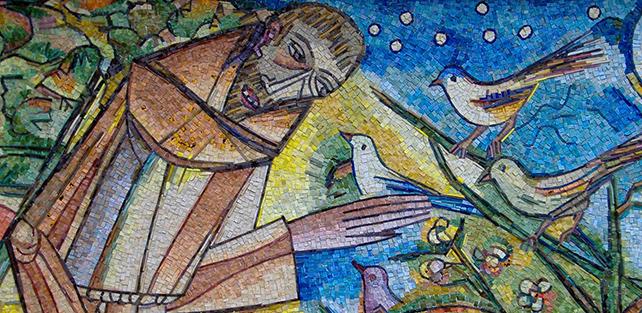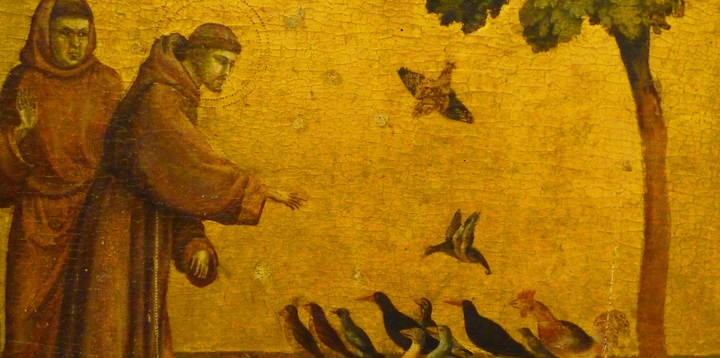 Contrary to appearances, Francis and Camillus meet in the same vision of the world not so much because both of them perceive the creation as the teaching of revelation but, rather, because they refer it to Christ, thereby bringing out its feeling of brotherhood.
Contrary to appearances, Francis and Camillus meet in the same vision of the world not so much because both of them perceive the creation as the teaching of revelation but, rather, because they refer it to Christ, thereby bringing out its feeling of brotherhood.
Francis offers here material of a very original importance which cannot be compared to that any other saint. The Canticle of Creatures is a document which testifies in a sufficient way to a clear stance towards nature, from which he raises up a hymn of praise to the creator. Equivalent data at this level cannot be found in Camillus even though one can find in his life many sayings or examples of tenderness towards, and admiration for, the creation. However, this is not the point that interests us.
The convergence can be seen in a central idea that inspires the Canticle of the Creatures and at the same time all of what Camillus feels.
Some people have seen in the canticle of Francis an echo of psalms 148 or 135 or a paraphrase of the famous Hymn of the Three Young men to be found in Daniel 3:57ss. The reference could be plausible but it is not pertinent when attention is drawn to the list of beings who are invited to praise the Lord: rain, water, the sun, the moon and the stars. The central motif is another: the Christological idea of universal brotherhood. All things finds their place under the protection of God whose paternity has been given to us in Christ. It is in him that our relationship with God and things is installed.
God is the ineffable one: ‘niuno homo è digno te mentovare’. This, however, becomes expressible in the open form of the historical revelation of the incarnation. Christ manifests God as the Father and all beings as His creatures united by a feeling of fraternal solidarity.
In the Canticle of the Three Young Men in Daniel the relationship between God and things is that of the creator and creatures. In Francis it has the meaning of a family which comes together around the person of Christ. In the hymn of Daniel, the appellation ‘brother and sister’ is not conceivable. The sun and the moon, night and day, dew and rain, heat and cold, can join man only in praise to God. In Francis they are already joined in brotherhood and the expression of praise is a consequent fact.
The second part of the Canticle of Creatures is a confirmation of the Christological motif. What comes into focus is wounded brotherhood which is in need of forgiveness: ‘Praise be to you, my Lord, for those who forgive because of your love’. The reference to the gospel message is explicit and more precisely it is linked to the prayer of ‘Our Father’, from which are taken both the petition of forgiveness and that of carrying out the will of God and liberation from the evil of sin. To this is then added the appeal, and lastly the reference, to the ineluctable event of death and the gift of resurrection.
Once the Christological approach is seen as the key to the interpretation of the creation, we are justified in moving on to the connection with the way in which Camillus feels the world. He was strongly fascinated by the gospel message of universal brotherhood. It is not so much in wonder before the enchantment of nature that Francis and Camillus encounter one another: their proximity is more subterranean; it is pervaded by the Christian spirit. If such was not the case, their emotions would only be of an aesthetic kind.
 In front of the spectacle of the rising sun, Camillus falls to his knees and prays: ‘Ants are also creatures of God’, Camillus observes and immediately adds a phrase of a typical gospel flavour, ‘they provide an example of how to provide for ourselves in this life of good works’. He thought about a lame dog in the following way: ‘He is a creature of God, and because I also have a bad leg I know how grave being able to walk is’. Camillus supplements the motif of being creatures with that of Christian solidarity, which arises in him in a spontaneous way when faced with suffering nature.
In front of the spectacle of the rising sun, Camillus falls to his knees and prays: ‘Ants are also creatures of God’, Camillus observes and immediately adds a phrase of a typical gospel flavour, ‘they provide an example of how to provide for ourselves in this life of good works’. He thought about a lame dog in the following way: ‘He is a creature of God, and because I also have a bad leg I know how grave being able to walk is’. Camillus supplements the motif of being creatures with that of Christian solidarity, which arises in him in a spontaneous way when faced with suffering nature.
The meeting of Francis and Camillus, as regard man’s relationship with the world, cannot be pushed beyond the Christological approach. The cosmic feeling of Camillus dwells mainly on the aspects of pain, to which he reacts with pity and help. In Francis the creation is more varied; it is full of sounds, colours, animals and plants. In nature he is surprised by wonder. It is a work offered to his eyes, to his hearing, to his touch, to his imagination, and to his faith in love. Beings are near to him because Christ, in making himself man and preaching universal love, exorcised them from their pagan neutrality. Francis feels their company. The world becomes for him a religious house where he is welcomed amongst brothers and sisters under the provident hand of a single father: God. The sun is a friar, like the wind and fire, as are Leone, Ginepro, Egidio and Bernardo; the moon is also a sister and water is ‘humble and precious and chaste’ like sister Chiara. Nobody is excluded from this universal family where even brother wolf finds his place.
The world of Francis is undoubtedly more intense and rich than that of Camillus. Despite this fact, the two draw close to one another in the central motif that draws upon Christ. In their eyes, nature loses the turbid characteristics of pagan hedonism and becomes the temple of a broad-ranging liturgy.















Camillians on Facebook
Camillians on Twitter
Camillians on Instagram